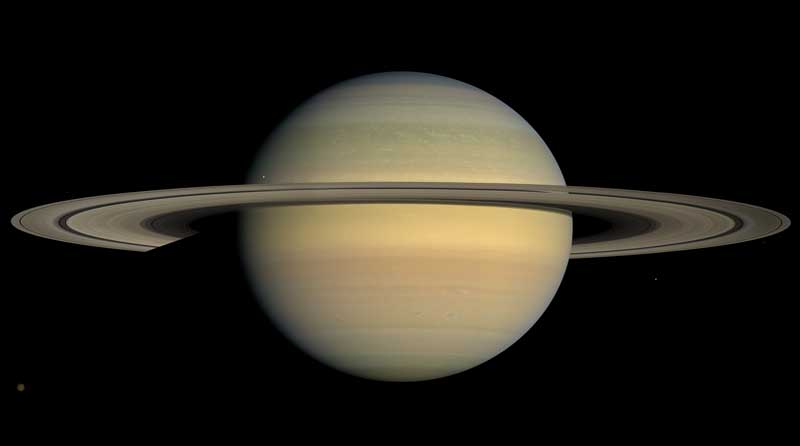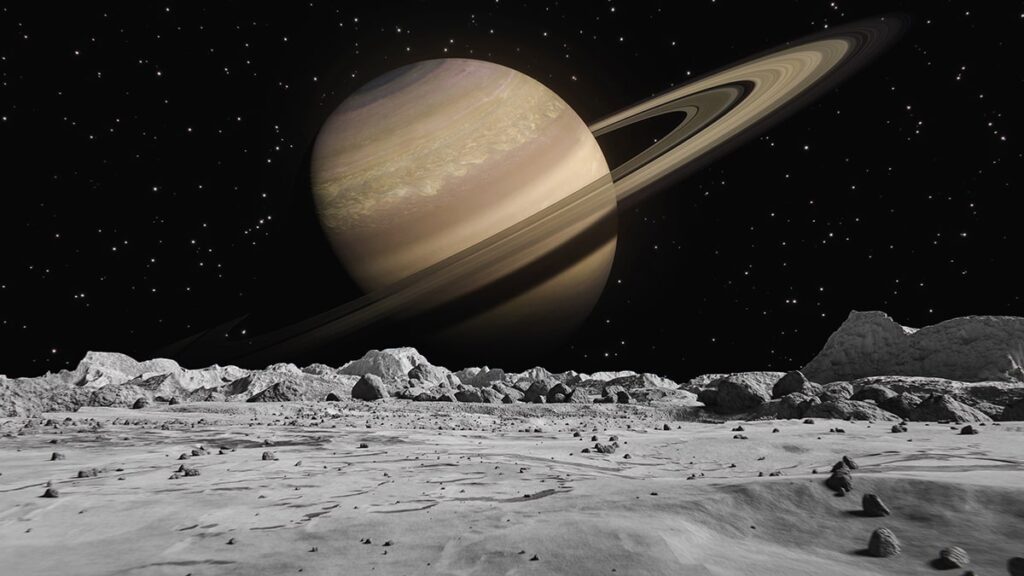- The sun: Saturn is the sixth planet from the sun. Its distance to the sun is 1.4 trillion kilometers
- Visibility: Only 5 of the solar system’s planets can be seen with the naked eye from Earth; of these, Saturn is the most distant
- Surface: Saturn is a gas planet (also known as a ‘gas giant’) and therefore has no solid surface. The yellowish “bands” seen on the planet’s surface are winds combined with heat from the planet’s interior
- Atmosphere: Saturn’s atmosphere consists mainly of hydrogen and helium. Winds in the atmosphere can reach speeds of up to 500 m/s. In comparison, the speed of the strongest wind ever measured on Earth is 408 km/h
- Rings: Saturn has the most distinctive and spectacular ring system of all the planets in the solar system. It contains 7 rings that are primarily composed of ice and are separated by a sort of gap. The ring system extends hundreds of kilometers into space, but the height is only about 10 meters in the main rings
- Moons: Saturn has 53 known moons and another 9 moons are pending approval by the International Astronomical Union (IAU)
- Spacecraft: So far, 5 missions have been sent to Saturn. The Cassini spacecraft arrived at Saturn in 2004 and is currently orbiting the planet
- Magnetic field: Saturn’s magnetic field is 578 times stronger than Earth’s
- Hexagon: Saturn has a giant hexagon around its north pole that is 25,000 km wide and about 100 km deep. However, little is known about this hexagon and it has not been observed on any other planets
- Name: The name Saturn has its origins in Roman mythology, where Saturn was the god of grain and harvest. Saturn is also the root of the English word for Saturday ‘saturday’

Fact: Saturn has 7 rings that extend hundreds of kilometers into space, but are only about 10 meters high
- Day: 1 day on Saturn (the time it takes Saturn to rotate once on its axis) is 10.7 hours. Saturn rotates almost as fast as Jupiter, making it the second fastest rotating planet in the solar system. Although we know the length of a 24-hour day on Saturn (10.7 hours), we don’t know the length of a day. This is due to the gaseous nature of the planet
- Year: 1 year on Saturn (the time it takes Saturn to rotate once around the sun) equals 29 years on Earth
- Size: Saturn’s volume is 755 times greater than Earth’s. Saturn also contains about 95 times as much mass as Earth
- Density: Saturn has the lowest density of all planets and is also the only planet with a lower density than water. If there was a container of water big enough to hold the planet, it would float in it
- Core: At Saturn’s center is a core made up of rock, ice, water and other components that take on a solid form due to the high pressure and heat
| Saturn’s profile | |
| Mass: | 5,6846×1026 kg (95.152 x Earth) |
| Eccentricity: | 0,055723219 |
| Diameter at the equator: | 120.536 km |
| Circumference at the equator: | 378.675 km |
| Circulation speed: | 9.69 km/s |
| Aphelion: | 1,513,325,783 km |
| Perihelion | 1,353,572,956 km |
| Average distance from the sun: | 1,433,449,370 km |
| Surface temperature: | -178 °C (average) |


